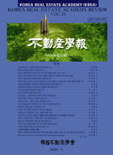- 영문명
- A Study on Housing Demand Estimation in Seoul
- 발행기관
- 한국부동산학회
- 저자명
- 오정석(Oh Jung Seok) 최승렬(Choi Seung Loul) 이영민(Lee Young Min)
- 간행물 정보
- 『부동산학보』不動産學報 第33輯, 181~192쪽, 전체 12쪽
- 주제분류
- 경제경영 > 경제학
- 파일형태
- 발행일자
- 2008.05.01

국문 초록
영문 초록
1. CONTENTS
(1) RESEARCH OBJECTIVES
The purpose of this study was to estimate the housing demand in Seoul. This study was based on the fact that housing demand has been had an effect on the change of forecasting population. We proceeded this study after writing the scenario which all situations are extended according to the current trend. The goal year was set in 2015 since we consider the housing policy of Seoul.
(2) RESEARCH METHOD
Regression analysis
(3) RESEARCH RESULTS
This study was to find out the effect of different regional characteristics on housing demand, based on population structure. For this study, We divided Seoul into 5 sections and housing demand was forecasted by housing demand function, based on population and population structure change.
Regional housing demand from 2008 up to 2010 and from 2011 up to 2015 was forecasted by the estimated population through regression analysis method. This study shows that total demand of housing is about 700,000 (from 2008 to 2010: 400,000 and from 2011 to 2015: 570,000)
2. RESULTS
As a result, Total demand of housing was about 700,000(from 2008 up to 2010: 400,000 and from 2011 up to 2015: 570,000). The core of a city is 93,066, West-north area is 205,596, West-south area is 264,014, East-north area is 180,594, and East-south area is 230,879.
(1) RESEARCH OBJECTIVES
The purpose of this study was to estimate the housing demand in Seoul. This study was based on the fact that housing demand has been had an effect on the change of forecasting population. We proceeded this study after writing the scenario which all situations are extended according to the current trend. The goal year was set in 2015 since we consider the housing policy of Seoul.
(2) RESEARCH METHOD
Regression analysis
(3) RESEARCH RESULTS
This study was to find out the effect of different regional characteristics on housing demand, based on population structure. For this study, We divided Seoul into 5 sections and housing demand was forecasted by housing demand function, based on population and population structure change.
Regional housing demand from 2008 up to 2010 and from 2011 up to 2015 was forecasted by the estimated population through regression analysis method. This study shows that total demand of housing is about 700,000 (from 2008 to 2010: 400,000 and from 2011 to 2015: 570,000)
2. RESULTS
As a result, Total demand of housing was about 700,000(from 2008 up to 2010: 400,000 and from 2011 up to 2015: 570,000). The core of a city is 93,066, West-north area is 205,596, West-south area is 264,014, East-north area is 180,594, and East-south area is 230,879.
목차
ABSTRACT
Ⅰ. 서론
Ⅱ. 선행연구 검토
Ⅲ. 인구추이를 통한 주택수요량 추정
Ⅳ. 결론
參考文獻
Ⅰ. 서론
Ⅱ. 선행연구 검토
Ⅲ. 인구추이를 통한 주택수요량 추정
Ⅳ. 결론
參考文獻
해당간행물 수록 논문
참고문헌
최근 이용한 논문
교보eBook 첫 방문을 환영 합니다!

신규가입 혜택 지급이 완료 되었습니다.
바로 사용 가능한 교보e캐시 1,000원 (유효기간 7일)
지금 바로 교보eBook의 다양한 콘텐츠를 이용해 보세요!



